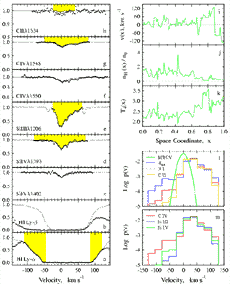Monte Carlo inversion of hydrogen and metal lines from QSO absorption spectra
The primary
objective of the study is the investigation of the physical
properties and chemical composition of matter at different
cosmological epochs. The investigation is based on high-resolution
spectral observations of hydrogen and metal (C IV, Si IV, O VI and others)
absorption-line profiles and advanced models of the radiative transfer
in random media.
Currently, there are two methods to analyse
absorption spectra:
a conventional Voigt-profile fitting (VPF)
procedure which usually assumes several subcomponents
with their own physical parameters
to describe a complex absorption profile, and
a mesoturbulent approach which describes the line formation process
in a continuous medium with fluctuating
physical characteristics.
It is hard to favor this or that method if both of them provide good fitting.
But the observed increasing complexity of the line profiles with increasing spectral resolution
gives some preference to the model of the fluctuating continuous medium.
 We set forward a mesoturbulent approach to measure D/H
and metal abundances, which has many advantages over the
standard VPF procedures.
A complete description of a new Monte Carlo inversion (MCI) method is given in
Levshakov, Agafonova and Kegel (2000a,b).
We set forward a mesoturbulent approach to measure D/H
and metal abundances, which has many advantages over the
standard VPF procedures.
A complete description of a new Monte Carlo inversion (MCI) method is given in
Levshakov, Agafonova and Kegel (2000a,b).
An example of the MCI analysis of a "H+D"-like profile
with accompanying metal lines
observed at za=3.514 towards
the quasar APM 08279+5255 is shown in Figure.
The high quality spectral data have been
obtained with the Keck-I telescope and the HIRES spectrograph by
Ellison et al. (1999).
A VPF analysis of the primordial D/H in the za=3.514 system
has been made by Molaro et al. (1999).
They found D/H=1.5*10-5
in the cloud with N(HI)=1.2*1018 cm-2.
Using MCI, we minimize the c2 value.
The objective function includes
those pixels which are critical to the fit. In Figure, these pixels are
marked by yellow.
In Figure (panels f and c),
the observed profiles of CIV1550 and,
respectively, SiIV1402
are shown together with the model spectra
computed with the
parameters derived from Ly-alpha, CII1334,
CIV1548, SiIII1206, and
SiIV1393 fitting to illustrate the consistency.
For the same reason the Ly-beta
model spectrum is shown in panel b
at the expected position.
All model spectra in Figure are drawn by continuous curves,
whereas filled circles represent observations (normalized fluxes).
The corresponding distributions of v(x), n(x)/n0, and T(x)
are shown in panels i, j, and k.
The restored
velocity field reveals a complex structure
which is manifested in non-Gaussian
density-weighted velocity distribution
as shown in panels l
and m for the total hydrogen as well as for the
individual ions.
We found that the radial velocity
distribution of HI in the vicinity of
v=-100 km/s
may mimic the deuterium absorption and, thus, the asymmetric
blue wing of the hydrogen Ly-alpha absorption may be
readily explained by HI alone.
The median estimation of the model parameters gives
N(H)=5.9*1018 cm-2 and N(HI)=5.3*1015 cm-2.
The MCI allowed us to fit precisely not only the blue wing of the
saturated Ly-alpha line but the red one as well.
We found that the actual neutral hydrogen column density
may be a factor of 250 lower than the value obtained by
Molaro et al. if one accounts for the velocity field structure.
Besides we did not confirm the extremely low metallicity
of [C/H]=-4.0, and [Si/H]=-3.5 reported by
Molaro et al. Our analysis yields
[C/H]=-1.8, and [Si/H]=-0.7. A similar silicon
overabundance has also been observed in halo (population II) stars.
We may conclude that
up-to-now deuterium was detected in only four QSO spectra
(Q1937-1009, Q1009+2956, Q0130-4021, and Q1718+4807)
where N(HI) was measured with
a sufficiently high accuracy. These measurements
are in concordance with D/H=(3-4)*10-5.
References
Ellison, S. L., Lewis, G. F., Pettini, M., Sargent, W. L. W.,
Chaffee, F. H., Foltz, C. B., Rauch, M., Irwin, M. J.
1999, PASP, 111, 919
Levshakov, S. A., Agafonova, I. I., Kegel, W. H. 2000a,
A&A, 355, L1
Levshakov, S. A., Agafonova, I. I., Kegel, W. H. 2000b,
A&A, 360, 833
Molaro, P., Bonifacio, P., Centurion, M., Vladilo, G. 1999,
A&A, 349, L13
 We set forward a mesoturbulent approach to measure D/H
and metal abundances, which has many advantages over the
standard VPF procedures.
A complete description of a new Monte Carlo inversion (MCI) method is given in
Levshakov, Agafonova and Kegel (2000a,b).
We set forward a mesoturbulent approach to measure D/H
and metal abundances, which has many advantages over the
standard VPF procedures.
A complete description of a new Monte Carlo inversion (MCI) method is given in
Levshakov, Agafonova and Kegel (2000a,b).